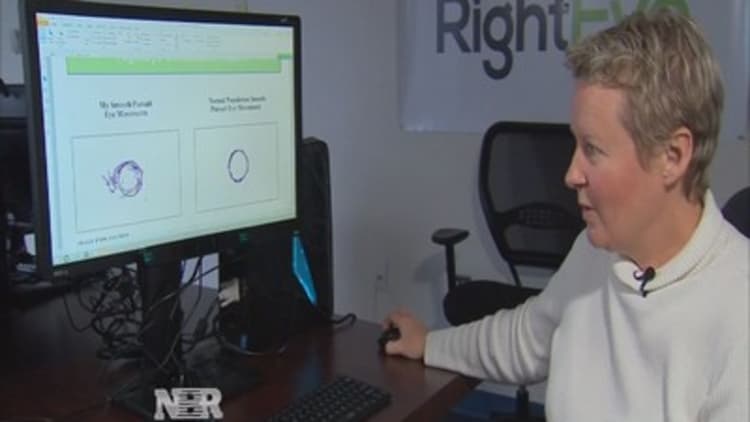
While on a family vacation in Paris this summer, 14-year-old Katie Rothstein fell off a Segway, hitting her head. She felt dizzy at first, but she seemed to recover quickly. Plus, she was wearing a helmet. Her parents thought she was fine.
Almost three weeks later, her mother, Adrienne Rothstein, brought Katie in as a volunteer to help her friend's company, RightEye, test its new eye-tracking software, Neuro Vision.
One of the tests Neuro Vision can perform is smooth pursuit. It works like a doctor does when a patient is asked to follow, or track, the doctor's finger. In that test, the doctor watches the patient's eyes to see if they are following the movement smoothly. However, Neuro Vision's measurement is more precise in gauging how well — or how poorly — the patient's eyes are tracking.
To Rothstein's surprise, the test indicated that Katie was suffering from concussion-like symptoms.
"My brother is an emergency room doctor, so I knew what to look for and that's why this was very shocking," she said.
As you can see from Katie's test (image below), the pattern her eye created was supposed to be a near perfect circle, but instead, her eyes danced around creating a scattered pattern, which is typical in patients who have a concussion.
Aug. 19, 2015
The number of head trauma patients treated in emergency rooms has jumped nearly 70 percent in the last 10 years, according to the Centers for Disease Control. Expensive CT scans and MRIs detect bleeding and tissue swelling, but are not effective for diagnosing concussions.
Participating in normal activity and risking even minor trauma to the head after a concussion can make the injury far worse, which is why Melissa Hunfalvay, RightEye's chief science officer and co-founder, saw a need for her firm's machine.
"One of the problems with concussion is not being able to accurately and sensitively assess what's going on and then know when it's OK to go back in," she explained.
Not only can Neuro Vision help doctors diagnose an initial concussion, the start-up's machine also gauges the brain's healing process, as you can see from Katie's later testing (images below). Instead of making a judgment call, it allows doctors to measure how far a patient is from normal. As you can see from Katie's test on Nov. 2, with time and rest she tested within normal parameters and no longer showed signs of a concussion.
Aug. 28, 2015
Nov. 2, 2015
Hunfalvay played tennis professionally for two years in the mid-1990s. She left the sport for school, where she studied the difference between elite athletes and weekend warriors, particularly how their eyes behaved. She learned highly skilled players don't just focus on the ball, but on their opponent's movements, too. She also discovered that stress and emotions can have an impact on eyesight.
"Whether it's a surgeon, an athlete, military personnel, their vision will change if they're not able to control their emotions. That's where things really started to expand, because it was not just a project now about tennis, it was a project about life," Hunfalvay explained.
Hunfalvay created eye-tracking technology and consulted for the military for seven years. She has also worked with Major League baseball but her equipment was expensive and bulky. It also took her several weeks to digest her data and come up with recommendations.
That all changed after she met an entrepreneur named Adam Gross in late 2011. With a background in health care and data analysis, Gross helped her develop practical applications.
After doing market research to find out what types of tests were needed, Hunfalvay and Gross created Neuro Vision, a digital eye tracker that can do more than just test for a concussion.
Dr. Leonard Press, a New Jersey optometrist, has been using RightEye's technology for several months and sees endless possibilities.
"It's going to be (used on) the stroke patients, the sports injuries, concussions, but there are just so many applications. In my mind the challenge is not to figure out who to use it for, but who to figure out not to use it for," Press said.
Besides diagnosing concussions, RightEye's tests can make it easier for specialists to uncover vision problems. Press said he expects current testing is out of date.
"The idea behind putting you at an eye chart and you read letters is really impoverished. You can have wonderful eyesight and still be having problems performing navigating, driving, reading, so we really need to bring the technology up to the 21st century," Press said.
The potential benefits for athletes were obvious to Major League Baseball's Pittsburgh Pirates, who have already bought RightEye's new technology.
RightEye President Barbara Barclay estimates there is a huge market for the product. "Just in optometry alone, that's over a billion-dollar market," she said.
RightEye expects it can make an even greater impact if it can become a faster and more cost-efficient way to help schoolchildren uncover reading disorders, since reading ability has been linked to graduation and even juvenile delinquency rates.
The company is working on more extensive eye tests, which it expects to roll out by the end of the year.
"There are large populations in this country, where these kids are not getting screened appropriately and no one's paying attention to them. If it impacts their ability to be successful in school, it's going to impact their ability to be successful in life and we take that very seriously and we want to have an impact," said Gross.
— CNBC's Andy Rothman contributed to this report.






